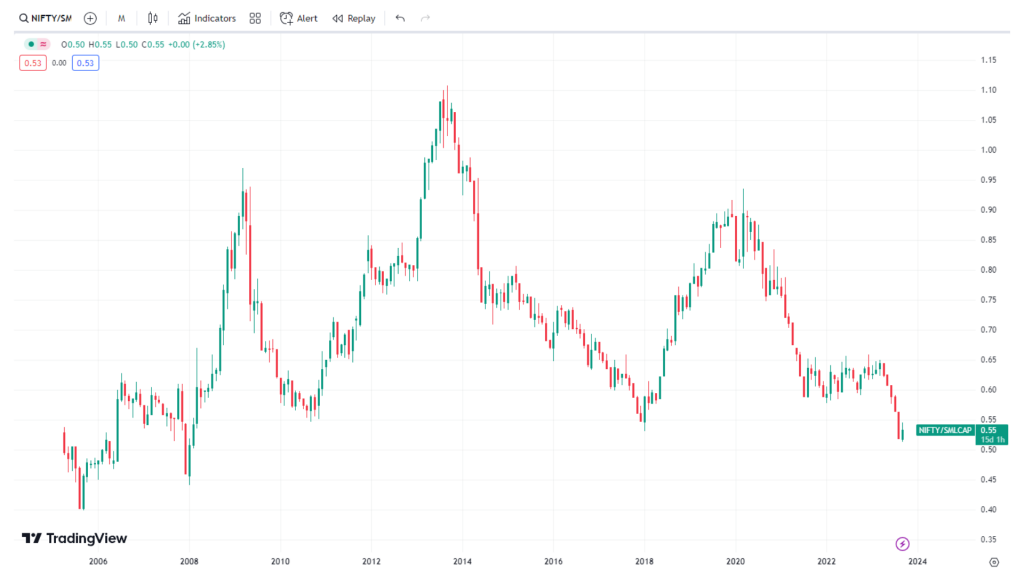The stock market is a complex and dynamic environment, influenced by various factors. One important aspect to consider when analysing the market is the ratio between the Nifty and the Small Cap index. This ratio provides valuable insights into the market’s performance and the relative strength of large caps and small caps.
Understanding the Nifty-Small Cap Ratio

The Large Cap – Small Cap ratio is calculated by dividing the Nifty 50 index by the Small Cap index, with the BSE Small Cap index being the preferred choice due to its extensive historical data. This ratio measures the weightage or the proportion of the market’s move between large caps and small caps.
How to read this ratio chart ?
The ratio chart highlights the oscillations between large caps and small caps. It shows that these two sectors of the market usually don’t move in sync. Even in cases where they do, the differential in their behavior is significant.
The range of the Nifty-Small Cap ratio is approximately 0.5 on the downside to 1 on the upside. When the Nifty index rises, the ratio also rises, indicating the outperformance of large caps. Conversely, when the Small Cap index rises at a faster rate, the ratio drops, revealing the strength of small caps.
Digging into the past !
Analyzing the historical movements of the Nifty-Small Cap ratio provides valuable insights into the market dynamics and the relative performance of large caps and small caps. Let’s examine a few examples from the chart to understand better.
2008 Financial Crisis
During the 2008 peak, the Nifty-Small Cap ratio was around 0.45, indicating that small caps were falling much faster than large caps. Over a span of 15 months, the ratio climbed from 0.5 to 1, implying that even though both large and small caps were falling, holding large caps would have been a wiser choice.
Recovery Phase
In the subsequent recovery phase, small caps started recovering faster than large caps, causing the ratio to fall to 0.55 within a year. This trend continued until large caps out performed small caps from September 2010 to 2013, resulting in the ratio reaching 1.5.
After the elections in 2013-2014, small caps performed exceptionally well, leading to a decline in the ratio from 1.1 to 0.55. This phase coincided with the SEBI dictating that mutual funds should reduce their exposure to mid and small caps, favoring large caps. Consequently, the ratio moved upward to 0.95.
COVID-19 Pandemic
During the post-COVID period, small caps experienced a significant rally, causing the ratio to decline. However, the recent small cap rally has brought the ratio back to 0.55. It appears that the benchmark bottom for this ratio may have been achieved, suggesting that the relative advantage of small caps over large caps may diminish.
What does it mean to you ?
Analysing the historical movements of the Large Cap – Small Cap ratio provides insights into potential investment strategies. While historical performance cannot guarantee future outcomes, this analysis suggests that small caps may not outperform large caps significantly in the near term.
Investors looking to relocate their portfolios can consider shifting more towards large caps, especially considering that large caps have not caught up with small caps’ performance. This decision aligns with the historical trend where large caps tend to go up more than small caps in the long run.
It is important to note that this analysis is based on historical patterns and trends, and market dynamics can change. However, incorporating these insights into investment decision-making can help investors make informed choices.
Download the WeekendInvesting App

If you have any questions for us. please write to us on support@weekendinvesting.com. You can also get on a 1-1 meeting with us should you need more clarity about the strategies or processes.









